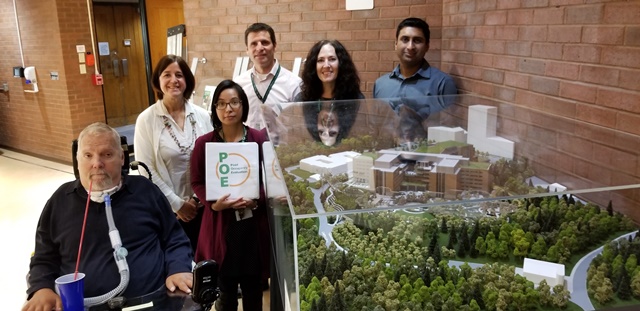By Mariela Castro
Embracing innovation has always been one of the fundamental pillars of West Park Healthcare Centre. At its recent “turning of the soil” ground-breaking event, the hospital celebrated a major milestone towards transforming its 115-year old campus into a world-class, integrated campus of care, with a new hospital at its core.
But the Centre is breaking ground in other areas, too. Before — and after — the new hospital becomes reality, it is taking measures to ensure the new building will be optimally designed to help patients get their lives back. And it is doing so via the Post Occupancy Evaluation (POE), an innovative, comprehensive initiative to improve healthcare design.
Healthcare design for the future
The POE will evaluate how the new hospital will affect employees, patients and their families, and operational efficiencies, for six significant design elements: Outdoor/Green Spaces (the connection to nature); Family Zones; Integrated Bedside Terminals; Congregate Dining; Team Substations; and Decentralized Patient Registration. Planned for 2018 through to 2025, the study will result in a comprehensive report for the Ministry of Health and Long-Term Care (MOHLTC), contributions to scientific literature, and the publication of quantitative and qualitative results manuscripts, a methodology paper, and a “lessons learned” report.
While by definition the POE is “the process of evaluating buildings in a systematic and rigorous manner after they have been built and occupied for some time*”, for West Park, the POE extends beyond evaluating the new hospital after the move-in date. The study of the hospital’s design, use and operating conditions is being conducted pre- and post-occupancy.
“Healthcare redevelopment projects within Ontario now require a post-occupancy evaluation be conducted. By analysing evidence gathered from research, these evaluations will help the industry and the hospital understand what design elements work best, and in what context. As we move forward with healthcare developments, it is crucial that we understand the full impact of how designs affect outcomes,” explains Martha Harvey, Senior Project Manager, Clinical Integration at West Park.
Evidence-based design
As part of an evidence-based design process, robust feedback is being collected from stakeholders on how the hospital supports the organization and its staff, volunteers, patients and patient friends and family. “The POE is a notable example of West Park’s focus on applying stringent scientific rigour to its innovation projects,” adds Jan Walker, VP-Strategy, Innovation and CIO, and head of the Centre’s cutting-edge Research and Innovation department. “POE data is gathered through rigorous survey methodology including questionnaires, focus groups, interviews, and observational monitoring. It supports the goals of the new hospital project, and aligns with the Health Quality Ontario framework, Senior Friendly Design and the WELL Building Standard. It also takes into consideration MOHLTC planning principles, and is judiciously reviewed and approved by the Joint Research and Ethics Board.”
Patient and family collaboration
Patient and family involvement is also key. In keeping with the Centre’s focus on patient and family-centered care, the Patient Experience Department plays a critical role in ensuring the voices of each of West Park’s varied populations are heard. Coordinator Sarah Benn-Orava is heavily involved in recruiting patients and their family members to solicit their input. “Our patients are thrilled to be able to share their West Park experience,” she says. “Patient and family engagement is at the foundation of West Park culture. Documenting their insights and feedback is tremendously meaningful for each of the six POE projects.”
Shelley Ditty, VP of Campus Development and Support Services, concurs. “Hospital design is an integral part of the patient and family experience, and we want to ensure the new building design contributes to better outcomes for our patients. Ultimately, great design aims to bring about a great patient and family experience — bringing services, programming and staff expertise more directly to the patient, better integrating research with patient care, and fostering collaboration between departments,” Ditty says. “The POE will greatly contribute to strategic planning and decision-making for campus development.”
A bold future ahead
Scheduled to open in 2023, the new West Park hospital represents the future of healthcare. By integrating leading-edge, evidence-based architectural design into its campus, West Park is poised to help patients faced with life-changing health challenges reclaim their lives and realize their potential, for decades to come.




